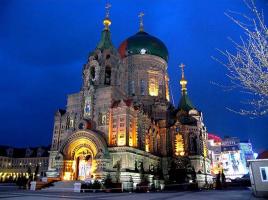The Russian Influence & Russians in Harbin
Harbin today is still very much influenced by its Russian past. A city once under Russian rule, it is now a center of trade with that country. The influence of Russia came with the construction of the China Far East Railway, an extension of the Trans-Siberian Railway, and Harbin, known formerly as a fishing village, began to prosper as the largest commercial center of North Eastern Asia.
Settlement in Harbin
In 1896, an agreement was signed in Beijing regarding the Russian control of the China Eastern Railway. The agreement stated that only Soviet and Chinese citizens could be employed for railway construction. In fact, Tsarist Russia encouraged Russian settlement in their important Trans-Siberian-Railway outpost by waiving the then 25-year long military service obligation for patriotic reasons.
Thus thousands and thousands of Russian engineers, railway builders, employees, Tsarist army soldiers and their families came as the first generation of Harbin Russians mostly to Harbin for the Chinese Eastern Railway. They moved to Harbin in order to work on the railroad. At the time Harbin was not an established city. The city was almost built from scratch by the builders and early settlers. Houses were constructed, furniture and personal items were brought in from Russia. After the Russo-Japanese War, while many Russians left Harbin, a lot of long-time residents decided to stay. By 1913, the Russian population is up to 43091, taking 63% of the total city citizens and Harbin had become an established Russian colony for the construction and maintenance work on the China Eastern Railway.
In the decade from 1913 to 1923, Russia went through World War I, the Russian Revolution, and the Russian Civil War. In the 1920s Harbin was flooded with 100,000 to 200,000 Russian White emigres fleeing from Russia. They were mostly officers and soldiers involved in the White movement, members of the White governments in Siberia and Russian Far East. There were both the intelligentsia and ordinary people. Harbin held the largest Russian population outside of the state of Russia.
On September 8, 1920, the Chinese Republic announced that it would no longer recognize the Russian consulates in China. On September 23 China ceased relations with representatives of Imperial Russia and deprived Russians of extraterritorial rights. Overnight Russians in China found themselves stateless. Shortly afterward, the Chinese government took over control of the institutions in Harbin such as courts, police, prison, post office, and some research and educational institutions.
In the 1930s, the Japanese occupied Manchuria, and turned it into the puppet state of Manchukuo. In 1935, the Soviet Union sold its share of the China Eastern Railway to Japan via Manchukuo. In the spring and summer of 1935, thousands of Harbin Russians went on trains with their passports and belongings, and left for the Soviet Union.
From 1932 to 1945, Harbin Russians had a difficult time under the Manchukuo regime, and the Japanese occupation. Some Harbin Russians initially thought the occupation was good, hoping that the Japanese would help them in their anti-Soviet struggles and provide protection from the Chinese, who were desperately trying to restore the sovereignty of Harbin.
Many Harbin Russians returned to the Soviet Union after 1935. Nearly all of them were arrested during the Great Purge (1936–1938), charged with espionage and counter-revolutionary activity according to the NKVD Order no. 00593 of September 20, 1937. Some Harbin Russians moved to other cities such as Shanghai, Beijing, Tianjin, Qingdao, and eventually left China. By the 1930s, Shanghai's Russian community had grown to 25,000.
After World War II
This section does not cite any references or sources. Please help improve this section by adding citations to reliable sources. Unsourced material may be challenged and removed. (May 2010)
In 1945, after the Soviet Army occupied Harbin, the Soviets sent all those Harbin Russians whom they identified as White Guardists and those who had collaborated with the Japanese authorities to labor camps. After 1952, the Soviet Union initiated a second wave of repatriation of Harbin Russians. By the mid-1960s virtually all Harbin Russians had left Harbin. There were several Russian connections in Australia resulting from refugees leaving Harbin. A good portion of the Russian Old Believers left to South America.
Influence
Due to the strong decades' presence of Soviet Russians, Harbin city a profound Russian style in architecture, education, art, food, clothing, language and more aspects of life.
Famas as Russian Orthodox Saint Sofia Church, The architecture style of Harbin shows a unique combination of oriental and European architecture styles. The city is well known for its unique, Russian and other European-influenced architecture. The architecture in Harbin brings the city the name of "Oriental Moscow" and "Oriental Paris".
The local cuisine in Harbin is also Russian-influenced. Harbin's bakeries are famous for their bread da-lie-ba(大列巴) in local dialect, derived from the Russian word khleb for "bread". Harbin's sausages (harbin hong-chang) are another notable product, in that they tend to be of a much more European flavours than other Chinese sausages.
The term Harbin Russians or Russian Harbinites refers to several generations of Russians who lived in the city of Harbin, a major junction city on the Chinese Eastern Railway (CER), from approximately 1898 to the mid-1960s.
The people in the Soviet Union used the terms "KVZhDist" (Russian: КВЖДист, "person of the China Eastern Railway") and "Harbinets" (Харбинец, "Harbinite/person from Harbin") to refer to a person with any type of ties to the China Eastern Railway.

.jpg)













